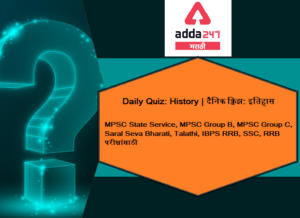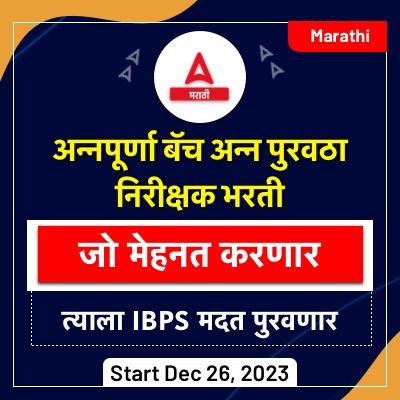
इतिहास दैनिक क्विझ मराठीमध्ये: 1 जून 2021
महाराष्ट्र राज्य लोकसेवा आयोग दरवर्षी वेगवेगळ्या परीक्षे मार्फत हजारो विद्यार्थ्यांची भरती करून घेते MPSC State Service, MPSC Group B, MPSC Group C, Saral Seva Bharati, Talathi, UPSC, SSC, RRB अशा अनेक परीक्षांमार्फत हजारो जागांची भरती दरवर्षी निघते ज्यात लाखो इच्छुक हजार किंवा त्याहूनही कमी जागांसाठी अर्ज करतात. आपण एमपीएससी आणि इतर परीक्षाची तयारी करत असाल तर आपल्याला क्विझ देण्याचे महत्त्व माहित असलेच पाहिजे. बर्याच विद्यार्थ्यांना अभ्यासाचे पुरेसे तास दिले जात असतानाही त्यांना या परीक्षांची पूर्तताही करता आली नाही कारण ते त्यांचे परीक्षण वेळेवर पूर्ण करू शकत नाहीत आणि संशोधन करण्याचा उत्तम मार्ग म्हणजे त्या संबंधित विषयाची किंवा विषयाची क्विझ देणे कारण आपण या मार्गाने कव्हर करू शकता कमी वेळात जास्तीत जास्त विषय. आम्हाला Add 247 मराठी येथे चांगल्या अभ्यास सामग्रीचे मूल्य समजले आहे आणि म्हणूनच आम्ही सर्व विषयांसाठी आपल्याला क्विझ प्रदान करीत आहोत. दैनिक क्विझ देऊन तुम्ही तुमच्या तयारीची पातळी तपासू शकता.
चालू घडामोडी, भूगोल, अर्थशास्त्र, पर्यावरण, सामान्य विज्ञान, इतिहास, पॉलिटी अशा सर्व स्पर्धात्मक सामान्य अभ्यास विषयांमध्ये इतिहासाचाही महत्वाचा वाटा आहे. तर चला इतिहास बद्दल तुमची तयारी तपासण्यासाठी खालील 1 जून 2021 ची इतिहासाची दैनिक क्विझ पहा.
Q1. अलीकडेच फ्रान्सचे राष्ट्राध्यक्ष इमॅन्युएल मॅक्रॉन यांनी 1994 मध्ये रवांडा हत्याकांडात आपल्या देशाच्या भूमिकेबद्दल क्षमा मागितली ज्यामध्ये जवळजवळ 800,000 लोक, बहुतेक वांशिक तूट्स्यांचा मृत्यू झाला._____मध्ये रवांडाला स्वातंत्र्य मिळाले-
(a) 1948
(b) 1972
(c) 1965
(d) 1992
Q2. तामिळ भाषेच्या व्याकरणावर दुसर्या संगमाचे आणि अस्तित्वातील फक्त एकमेव कार्य-
(a) पट्टुपट्टू
(b) टोलकाप्पीयम
(c) एथुथोगाई
(d) सिलप्पाटिकरम
Q3. 1927 च्या बटलर समितीचा उद्देश होता?
(a) केंद्र आणि प्रांतीय सरकारच्या कार्यक्षेत्रांची व्याख्या करा.
(b) भारताच्या राज्यसभेच्या अधिकारांची व्याख्या करा.
(c) राष्ट्रीय प्रेसवर सेन्सॉरशिप लावा.
(d) भारत सरकार आणि भारतीय राज्य यांच्यातील संबंध सुधारणे
Q4. खालीलपैकी कोका चळवळीशी संबंधित होते
1. भगत जवाहर माळ
2. बाबा रामसिंग
3. बक्षी जगबंधु बिद्यधर
योग्य कोड निवडा
(a) 1 आणि 2
(b) 2 आणि 3
(c) 1 आणि 3
(d) 1, 2 आणि 3
Q5. कुका चळवळीसंदर्भात पुढील विधानांचा विचार करा
1. त्यांनी हाताने विणलेले कपडे घालण्याचा सल्ला दिला
2. त्यांनी मांस व अल्कोहोलच्या सेवकास हतोत्साहित केले
3. त्यांना पंजाबवर शीख राज्य परत मिळवायचे होते
4. त्यांनी आंतरजातीय विवाहांना प्रोत्साहन दिले
वर दिलेले कोणते विधाने बरोबर आहेत?
(a) 1, 2, 3
(b) 2, 3, 4
(c) 2, 4
(d) 1, 2, 3, 4
Q6. नार्केलेरिया बंडखोरीच्या कारणास्तव खालील विधानाचा विचार करा
1. फरायझींवर दाढी-कर
2. जातीभेद
3. इंडिगो उत्पादकांवर कर
वर दिलेली कोणती विधाने बरोबर आहेत ?
(a) 1 आणि 2
(b) 2 आणि 3
(c) 1 आणि 3
(d) 1, 2 आणि 3
Q7. सय्यद मीर निसार अली, किंवा 1831 मध्ये नार्केलेरिया बंडखोरीचे नेतृत्व करणारे शेतकरी नेते टीटू मीर हे बर्याचदा इंग्रजांविरूद्ध पहिले सशस्त्र शेतकरी विद्रोह मानले जाते. या उठावाशी संबंधित होते-
(a) ओरिसा
(b) आसाम
(c) मद्रास
(d) बंगाल
Q8. पुढीलपैकी कोणत्याने पागल पंथीय बंडाला कारणीभूत ठरले?
(a) गोमदार कोंवर
(b) करम शाह
(c) हाजी शरीयत-अल्लाह
(d) राय बरेलीचे सय्यद अहमद
Q9. फॅरायझिस संबंधित खालील विधानांचा विचार करा
1. हाजी शरीयत-अल्लाह यांनी स्थापन केलेल्या मुस्लिम पंथांचे अनुयायी फराहे होते
2. जमींदारांविरूद्ध भाडेकरूंच्या कारणास पंथाने समर्थन दिले नाही
3. फरायझी हे वहाबी चळवळीचे प्रखर विरोधक होते आणि त्यांनी कधीही पाठिंबा दर्शविला नाही.
वर दिलेले कोणते विधान/विधाने बरोबर आहे/ आहेत?
(a) 1 आणि 2
(b) फक्त 3
(c) फक्त 1
(d) 1, 2, 3
Q10. कुकिजांच्या विद्रोह संदर्भातील खालील विधानांचा विचार करा
1. सिक्कीममध्ये याचे आयोजन करण्यात आले होते
2. पहिल्या महायुद्धात कामगार भरती करण्याच्या ब्रिटीश धोरणांच्या विरोधात हे आयोजन करण्यात आले होते
वर दिलेले कोणते विधान/विधाने बरोबर आहे/ आहेत?
(a) फक्त 1
(b) फक्त 2
(c) दोन्ही 1 आणि 2
(d) 1 किंवा 2 देखील नाही
महाराष्ट्र राज्यातील सर्व स्पर्धा परीक्षांचे मोफत अभ्यास साहित्य
YouTube channel- Adda247 Marathi
App- Adda247 (मराठी भाषा)
Use Coupon code: HAPPY
आणि मिळवा 75% डिस्काउंट
आता तुमच्या घरी लाइव्ह वर्ग मराठीत उपलब्ध आहेत
केवळ सरावच परीक्षेत चांगले गुण मिळण्यास मदत करू शकतो
SBI लिपिक फाउंडेशन बॅच | द्विभाषिक
Solutions
S1.Ans.(c)
Sol.
From 1894 to 1918, Rwanda, along with Burundi, was part of German East Africa. After Belgium became the administering authority under the mandates system of the League of Nations, Rwanda and Burundi formed a single administrative entity; they continued to be jointly administered as the Territory of Ruanda-Urundi until the end of the Belgian trusteeship in 1962. By then, however, the two states had evolved radically different political systems. Rwanda had declared itself a republic in January 1961 and forced its monarch (mwami), Kigeri, into exile.
https://www.britannica.com/place/Rwanda/Rwanda-under-German-and-Belgian-control
S2.Ans.(b)
Sol.
Tolkappiyam is the only surviving work of the second Sangam and earliest work on the grammar of the Tamil language and the earliest extant work of Tamil literature.
S3.Ans.(d)
Sol.
The Butler Committee (1927) was set up to examine the nature of the relationship between the states and Government
S4.Ans.(a)
Sol.
The Kuka Movement was founded in 1840 by Bhagat Jawahar Mal (also called Sian Saheb) in western Punjab. A major leader of the movement after him was Baba Ram Singh. (He founded the Namdhari Sikh sect.) After the British took Punjab, the movement got transformed from a religious purification campaign to a political campaign. Its basic tenets were the abolition of caste and similar discriminations among Sikhs, discouraging the consumption of meat and alcohol and drugs, permission for intermarriages, widow remarriage, and encouraging women to step out of seclusion
S5.Ans.(d)
Sol.
Its basic tenets were the abolition of caste and similar discriminations among Sikhs, discouraging the consumption of meat and alcohol and drugs, permission for intermarriages, widow remarriage, and encouraging women to step out of seclusion. On the political side, the Kukas wanted to remove the British and restore Sikh rule over Punjab; they advocated wearing hand-woven clothes and boycott English laws and education and products. So, the concepts of Swadeshi and non-cooperation were propagated by the Kukas, much before they became part of the Indian national movement in the early twentieth century. As the movement gained in popularity, the British took several steps to crush it in the period between 1863 and 1872. In 1872, Ram Singh was deported to Rangoon
S6.Ans.(c)
Sol.
Narkelberia Uprising Mir Nithar Ali (1782-1831) or Titu Mir inspired the Muslim tenants in West Bengal to rise against landlords, mainly Hindu, who imposed a beard-tax on the Faraizis, and British indigo planters. Often considered the first armed peasant uprising against the British, this revolt soon took on a religious hue. The revolt later merged into the Wahabi movement
S7.Ans.(d)
Sol.
Mir Nithar Ali (1782-1831) or Titu Mir inspired the Muslim tenants in West Bengal to rise against landlords, mainly Hindu, who imposed a beard-tax on the Faraizis, and British indigo planters. Often considered the first armed peasant uprising against the British, this revolt soon took on a religious hue. The revolt later merged into the Wahabi movement
S8.Ans.(b)
Sol.
The Pagal Panthi, a semi-religious group mainly constituting the Hajong and Garo tribes of Mymensingh district (earlier in Bengal), was founded by Karam Shah. But the tribal peasants organized themselves under Karam Shah’s son, Tipu, to fight the oppression of the zamindars. From 1825 to 1835, the Pagal Panthis refused to pay rent above a certain limit and attacked the houses of zamindars. The government introduced an equitable arrangement to protect these peasants, but the movement was violently suppressed.
S9.Ans.(c)
Sol.
The Faraizis were the followers of a Muslim sect founded by Haji Shariat-Allah of Faridpur in Eastern Bengal. They advocated radical religious, social, and political changes. Shariat-Allah son of Dadu Mian (1819-60) organized his followers with an aim to expel the English intruders from Bengal. The sect also supported the cause of the tenants against the zamindars. The Faraizi disturbances continued from 1838 to 1857. Most of the Faraizis joined the Wahabi ranks.
S10.Ans.(b)
Sol.
Kukis’ Revolt (1917-19; Manipur); against British policies of recruiting labor during the first World War







